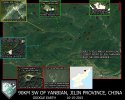From Henri K the 2nd ASBM DF 26. Interesting tidbit about how the missile controlled the speed in order to acquire and aim for the target. Another revealing thing is there are 4 brigades already assuming 18 missile that is 72 missile. with a range of 4000km anything east of GUAM is fair game now
Since the first public appearance of the
DF-26 at the military parade on 3 September 2015, this Chinese IRBM ballistic missile, officially presented as a missile that can be equipped with conventional or nuclear heads, to hit fixed targets on the ground or large targets In motion on the sea, attracts the curiosity of many observers.
A TEL of the ballistic missile DF-26 at the parade of 3 September 2015.
What then is this ballistic missile of last generation dual purpose, capable of reaching its target within a radius of 4 000 km, under its protection cap?
In a recent televised interview with Army General ZHAO Zong Qi (赵宗岐), commander-in-chief of the Western Theater of Operations and responsible for the most extensive defense zone in China, this mysterious DF- Is finally unveiled.
A brief passage from the TV interview reveals the face of the DF-26
Unsurprisingly, and as could already be guessed by the shape of the 1st stage, the atmospheric reentry part of this anti-aircraft ballistic missile (ASBM) is equipped with four aerodynamic fins to ensure its maneuverability in the final approach phase.
What is interesting is the dual-head configuration of the DF-26, which can be found on at least two other Chinese ballistic missiles - SRBM
DF-15B and MRBM
DF-21C - designed for high-precision targeting, And also on a former American ballistic missile of the US Army, the
MGM-31 Pershing II.
Four US and Chinese ballistic missiles operating the same configuration for the atmospheric reentry.
So why this "physical resemblance"?
Have the engineers of the two Chinese missile groups, CASC and CASIC, "copied" again as the media try to repeat it - for lack of technical arguments and probably to remain "politically correct" and to please the Public - or are there many special reasons because the physical laws are expressed in the same way for everyone living under the same sky?
The research paper "
", written by the chief engineer of the DF-26 program, ZHU Guang Sheng (朱广生), which belongs to the CALT Institute, Be given some explanation on the choice of this technical configuration.
ZHU first outlined the needs of its study for a maneuverable atmospheric reentry vehicle, which must perform large mid- and high-altitude maneuvers, rapid low-level trajectory changes, and controllable adjustments in position and speed during Of the terminal approach phase.
For this, the machine must have the following characteristics:
- Relatively large lift and high aerodynamic fineness
- A small margin of static stability
- Effective control of aerodynamic control surfaces
- A sufficient internal working volume
- Low load torque
- A controllable descent speed
A ballistic missile with an optimum trajectory of 4,000 km reaches a speed of more than 5 km / s after its propelled phase, and nearly 3.8 km / s, a little more than Mach 11 at the apogee Of its course. The lift of such a hypersonic gear, at the time of its atmospheric re-entry, comes mainly from its body, and the aerodynamic fineness of its form. The control surfaces only serve to control. Thus, the aerodynamic shape of the atmospheric re-entry head must meet the requirements of a high normal force and low axial force.
In order for the various sensors of the head to operate optimally, in particular in the case of an ASBM which combines the information coming from multiple sensors in order to be able to locate, identify and acquire its target, it requires that the descent speed be controllable. And the best way to regulate this velocity is by conical motion, that is, the velocity vector of the head rotates about its symmetrical axis.
And the form that meet all these criteria for such a head is precisely biconical. But the precise dimensions of this bi-cone so that the flight is optimum vary according to the speed of the craft, the mass, the barycentre and a set of parameters.
The variation of the normal force of the head as a function of the speed and the angle of incidence, for two typical profiles of cone.


